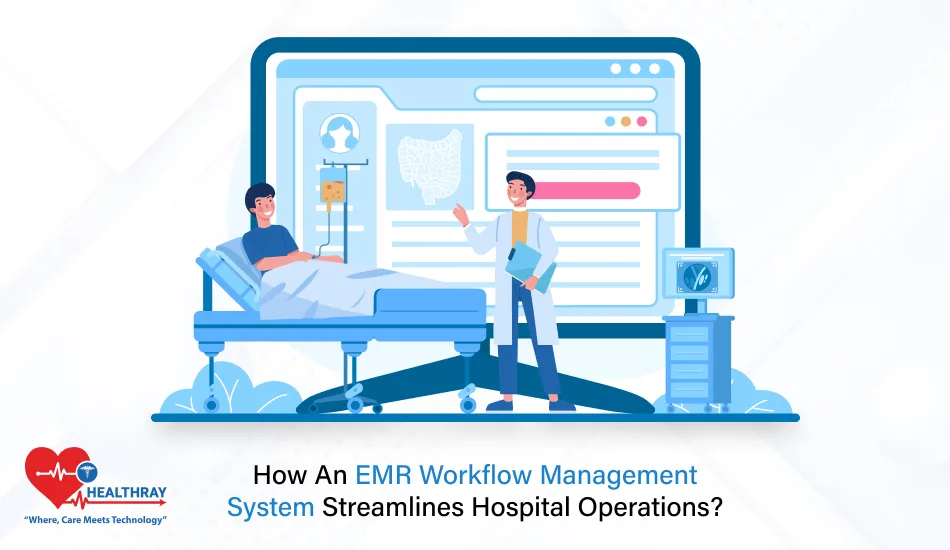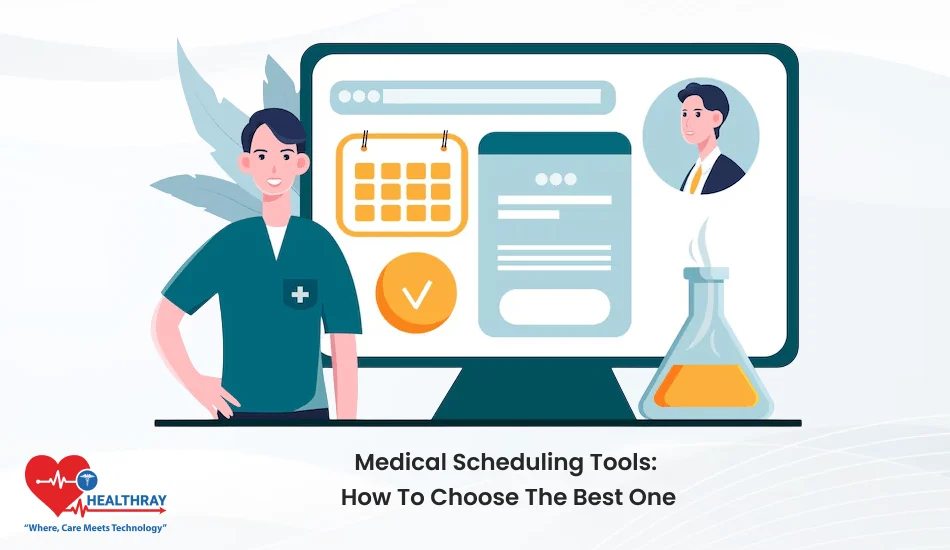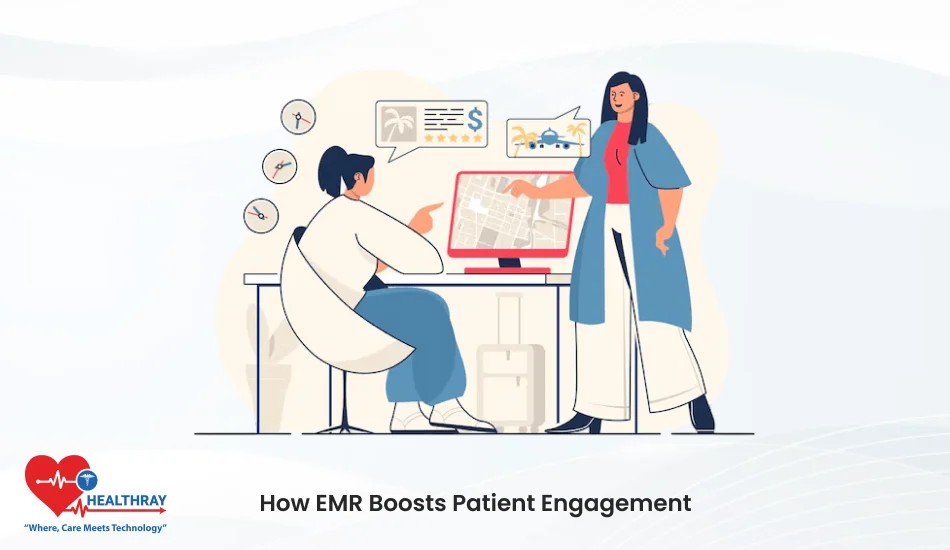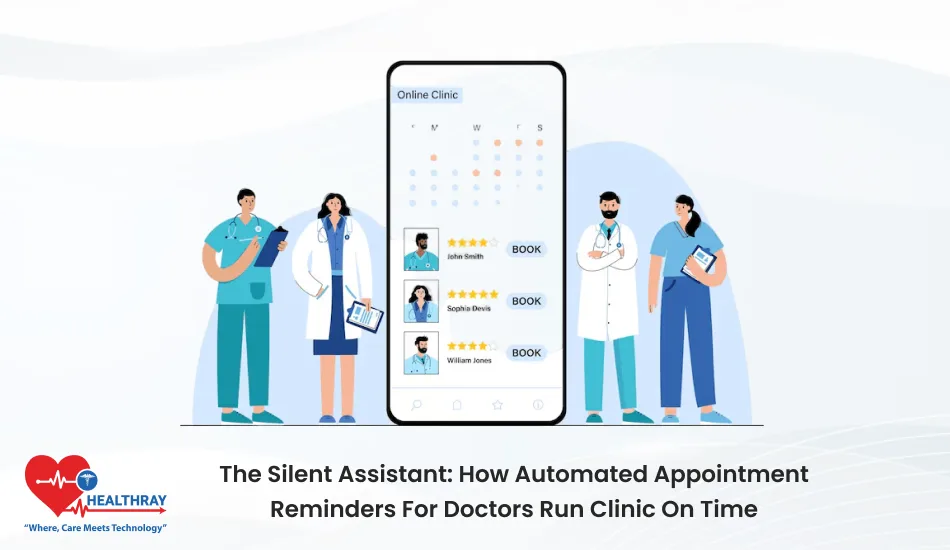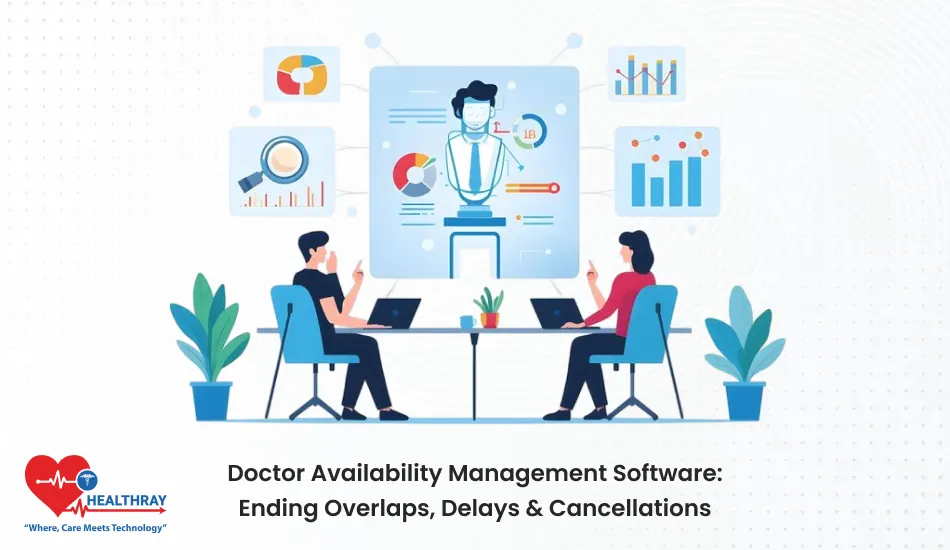Summary
Hospitals work best when every process runs in sync, and that’s where an EMR workflow management system shines. It turns the daily hospital chaos into sleek, intelligent workflows. It connects everything, from rapid patient check-ins to billing to updates in real time.
Doctors heal more, staff work more effectively, and patients receive faster, quality care. Hospitals using EMR medical software are not only digitised but also transformed into streamlined, data-driven, patient-centred, future-ready health care machines.
Introduction
What if hospitals could think and move as fast as the doctors who work in them? That’s the dream every modern healthcare team chases, and it starts with an EMR workflow management system. Imagine doctors skimming patient files, nurses receiving instant updates, and administrators managing billing like a breeze. Sounds futuristic? It’s happening right now.
Unlike old paper files that slowed everything down, smart EMR software pumps real-time rhythm into hospitals. It connects every corner wards, labs, pharmacies, waiting rooms so work never skips a beat. So, tasks that took hours are done in minutes.
Actually, it is more than tech: it is the digital heart of the hospital. It also frees the team to focus on what they should be doing: caring for patients. In this post, you will learn what the future of healthcare efficiency looks like, how it makes hospital life run more smoothly and saves you time.
What Is an EMR Workflow Management System?
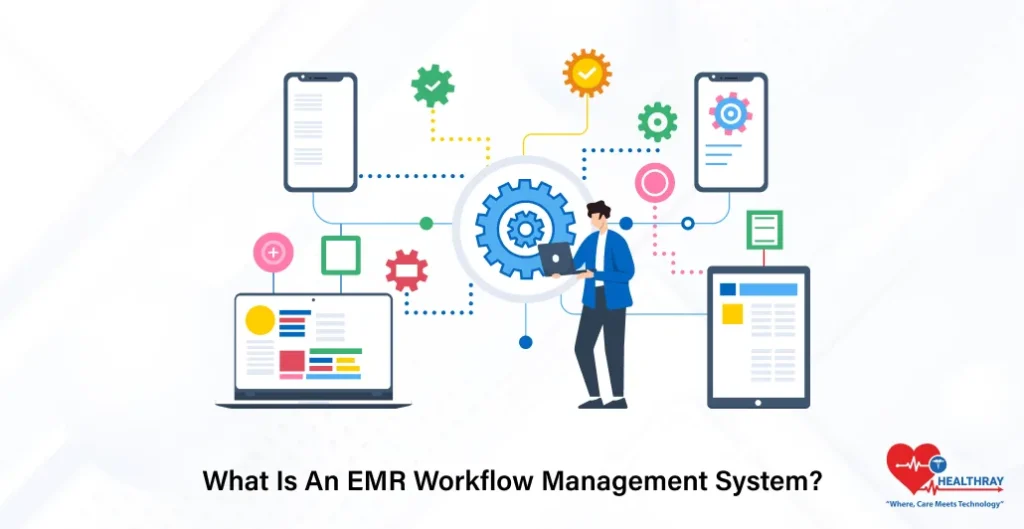
An EMR workflow management system is the brain of a modern hospital. It is what keeps everything linked, organised and perfectly synchronised.
But before the magic, let’s break it down.
EMR is short for Electronic Medical Records, the digital versions of patient charts that contain everything from allergies to lab results. Unlike paper files, which languish in dusty cabinets, EMRs are only a click away, always at the ready for when clinicians most need them.
Then add workflow management.
Now imagine a hospital where departments no longer work in silos. Results are available to doctors in real time. Nurses receive automatic alerts at medication time. Updates are sent to the billing department as soon as a service is completed. That’s how an EMR workflow management system connects everyone under one virtual roof. It substitutes disjointed messaging with integrated coordination.
Hospitals with good EMR software don’t simply preserve data; they apply it to aid their decisions more quickly. It guides each stage of the patient’s experience, from admission to discharge. It also automates work, minimises manual labour, eliminates lag time and ensures that nothing falls through the cracks.
Advanced EMR medical software also tracks performance and identifies gaps in workflow before they cause trouble. Also, since all data is updated in real time, doctors are always working with the most up-to-date information.
In other words, an EMR software system changes how hospitals think and function. It connects people, processes and technology into one powerful system. When every click saves a second and every second counts an EMR workflow management system is more than a tool; it is the pulse of modern healthcare.
Key Features of an EMR Workflow Management System
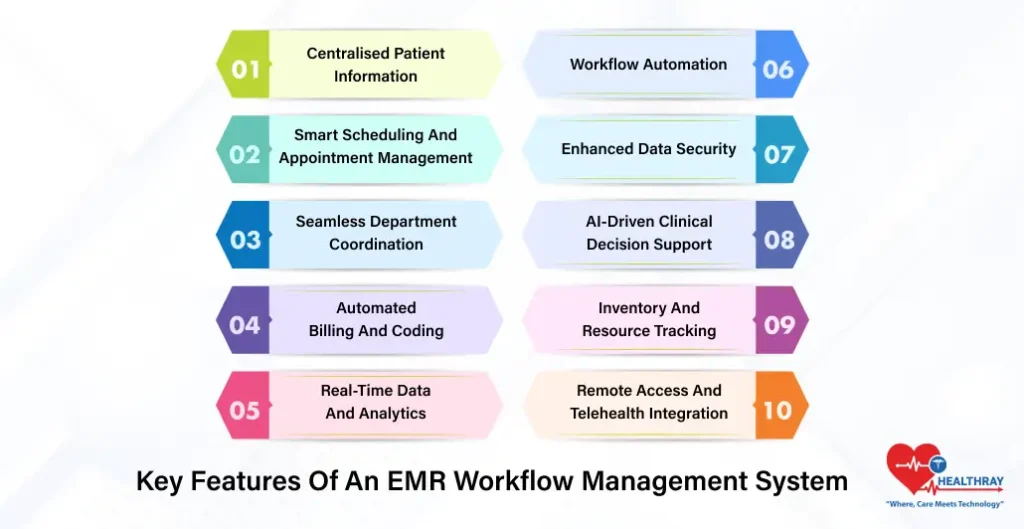
Let’s explore its features that make hospital operations faster, easier, and more accurate.
Centralised Patient Information
The electronic medical records software houses all patient information in a single secure digital location. Doctors and nurses no longer shuffle stacks of paper. Rather, they access all of it, from medical history to test results, in seconds.
It is also instant, so it saves time and lessens human error. All records are updated automatically in the system, ensuring that all users are working from updated information.
Smart Scheduling and Appointment Management
Scheduling is easy with advanced EMR medical software. Patients can make online appointments, and the system assigns time slots automatically, sends reminders, and notes cancellations.
This provides hospitals with the ability to reduce no-shows and waiting times. Doctors also find it easy to schedule their time and maintain a regular, smooth patient flow.
Seamless Department Coordination
An EMR workflow management system acts as a digital bridge between all the hospital departments. Physicians get reports instantly from the lab, and prescriptions are instantly updated for pharmacists.
This seamless collaboration diminishes lags and maximises the efficiency of efforts. Each department communicates clearly, and patients get faster, more accurate treatment.
Automated Billing and Coding
The billing and insurance claims process is handled painlessly by the electronic medical records software. It tracks services and charges, applies the appropriate medical codes, all without manual intervention.
This leads to fewer opportunities for billing mistakes. Hospitals receive payment more quickly, and staff have to deal with less paperwork.
Real-Time Data and Analytics
Today’s AI-based electronic medical records systems are not just capable of storing but also comprehending data. These systems process patient data and forecast resource allocations, assisting management in improving decision-making.
For instance, they can inform physicians of possible health dangers according to medical patterns. Hospitals use these insights to improve performance, reduce waste, to plan smarter.
Workflow Automation
The EMR medical software automates busy work that can suck up hours of time. It sends reminders, updates patient files and even manages referrals.
As a result of this automation, hospital personnel focus on patients rather than paperwork. Each task is unmistakably digital with no ambiguity.
Enhanced Data Security
More recently, in our digitized world, securing patient information is critical. An EMR system encrypts data and employs role-based access to protect sensitive data.
Access to or editing of records is restricted to authorised users only. This ensures compliance with privacy laws and fosters patient trust.
AI-Driven Clinical Decision Support
With AI-based electronic medical records systems, hospitals essentially have an unceasing digital assistant. These programs offer possible diagnoses, warn against dangerous combinations of drugs, and suggest treatment regimens based on previous research.
This helps doctors make quicker, safer and more informed decisions. It’s like having a second expert at every consultation.
Inventory and Resource Tracking
The EMR medical software also tracks hospital supplies in real time. It keeps track of stock levels, alerts users before they run out of something and helps manage inventory costs.
This kind of tracking avoids last-minute scrambles and ensures hospitals have what they need to help patients.
Remote Access and Telehealth Integration
Current AI-based electronic medical records systems extend outside the hospital. They support telehealth, which allows doctors to log in, view records, and connect with patients.
This allows for continuity of care, even if patients cannot come in for a visit. It also brings hospital reach to rural and remote areas.
Role of EMR Workflow Management System in Streamlining Hospital Operations
Let’s explore how it plays a powerful role in streamlining hospital operations.
Simplifying Patient Admission and Discharge
The EMR workflow management system begins when the patient enters the hospital. It captures patient information, such as contact information, medical history and insurance data in seconds. Say goodbye to lost files or tedious reams of paper forms. Instead, everything updates in the system automatically, which saves staff time and stress.
Upon admission, it immediately assigns a doctor, a bed, and even alerts the nurse assigned to the patient. On discharge, the same system takes over again, generating the reports, prescriptions, discharge summaries and billing information automatically. This speed reduces time wastage and improves the patient experience.
Discharges, which used to take hours, now take minutes, and patients leave with accurate documents and clear instructions. The process from admission to discharge is rapid, smooth and error-free through the EMR workflow management system.
Enhancing Communication Across Departments
Hospitals function like little cities, with labs, pharmacies, wards, and billing units dependent upon one another. Paper systems can impede and cloud this connection. But with EMR medical software, all departments communicate instantly.
A doctor ordering a test, for instance, means the lab receives the order immediately. The doctor is alerted when results are ready. Nurses also immediately see alerts related to changes in medication schedules or test results. In the same way, the pharmacy receives automatic notification of prescriptions, ensuring the timely delivery of medicines.
So, there’s always information flowing. There is no need to chase reports or duplicate data entry. Messages are instantaneous through the system, which allows for a minimization of mistakes in communication and better teamwork. Because it connects departments digitally, EMR medical software removes silos and leads to a more integrated and seamless hospital experience.
Automating Routine Administrative Tasks
Hospitals perform thousands of small but critical tasks each day, updating patient files, processing insurance claims, setting up appointments and billing. The electronic medical records software automates all of these, saving staff countless hours of manual work.
For example, when a patient completes treatment, the system automatically updates records, creates billing entries, and forwards invoices to the finance team. Patients receive reminder messages or emails about appointments automatically and without direct human involvement. Each nurse gets a computerized list of tasks specific to his or her shift, eliminating the possibility of overlooking any.
This automation reduces repetitive work and errors from fatigue or distraction. It also allows staff to focus on meaningful work like helping patients and improving service quality, instead of drowning in paperwork.
Step towards digital era with our healthcare solution
Revamp your hospital facilities and embrace change for better healthcare management. Ease in managing and organizing large medical datasets leads to effective analysis. Seize the opportunity now!
Improving Data Accuracy and Accessibility
There is a critical need for data accuracy in healthcare. A typo here or there in your patient’s information can create big headaches. The AI-based electronic medical records systems make all of that data accurate, up-to-date, and available.
Every action, doctor’s note, lab result, and prescription automatically syncs in real time across departments. This avoids either replication or obsolescence. Doctors also have immediate access to an integrated record of each patient’s history, including visits at outlying clinics and other branches of the hospital.
On top of that, the system incorporates intelligent validation procedures that are able to indicate when fields are left empty or if there is data inconsistency, and this alerts the staff to correct it on the spot. There is, as a result, a reliance on accurate, current information for every decision.
Supporting Smarter Decision-Making
Insights are essential for making modern hospitals run efficiently. The EMR software collects enormous amounts of data about operations, treatments, and performance. Rather than let this data go to waste, it transforms it into valuable information.
Administrators can check how long patients are waiting for an appointment, how many beds are empty, or where a department is backed up. The system produces reports that identify inefficiencies and allows leaders to take immediate action.
In addition, EMR software also goes beyond this by predicting future trends. They can predict patient flows, staff needs, and even patterns of risk in various diseases. For instance, if a large number of patients experience the same symptoms in one region, the system can notify management of a potential outbreak.
With such real-time intelligence, hospitals don’t just react; they plan ahead. Decisions are made more rapidly, more intelligently, based on actual data and a culture of constant improvement.
How to Choose the Right EMR Workflow Management System for Your Hospital?
Here are some best practices:
- First, determine your hospital’s size needs and workflow gaps.
- Select EMR medical software that’s easy to use and train on.
- Ensure that it integrates with billing, lab, and pharmacy systems.
- It should have adequate data security and privacy compliance.
- Choose vendors that provide 24/7 support and regular updates.
- Choose electronic medical records software that is scalable and can grow with your hospital.
- Seek out AI tools and analytics for better insights.
- Make sure to pilot the EMR workflow management system with actual hospital personnel before implementation.
Conclusion
These days, there is no alternative to efficiency in the fast-paced world of medicine. An EMR workflow management system turns hospitals into intelligent, smooth-running ecosystems, where every click is an opportunity.
With EMR medical software, doctors heal faster, staff work smarter, and patients feel like they are being cared for. This isn’t simply digitizing, it’s a rethinking of the experience of life inside a hospital. The future of healthcare is clear, connected, and powered by technology that saves time, saves effort, and most importantly, saves lives.
